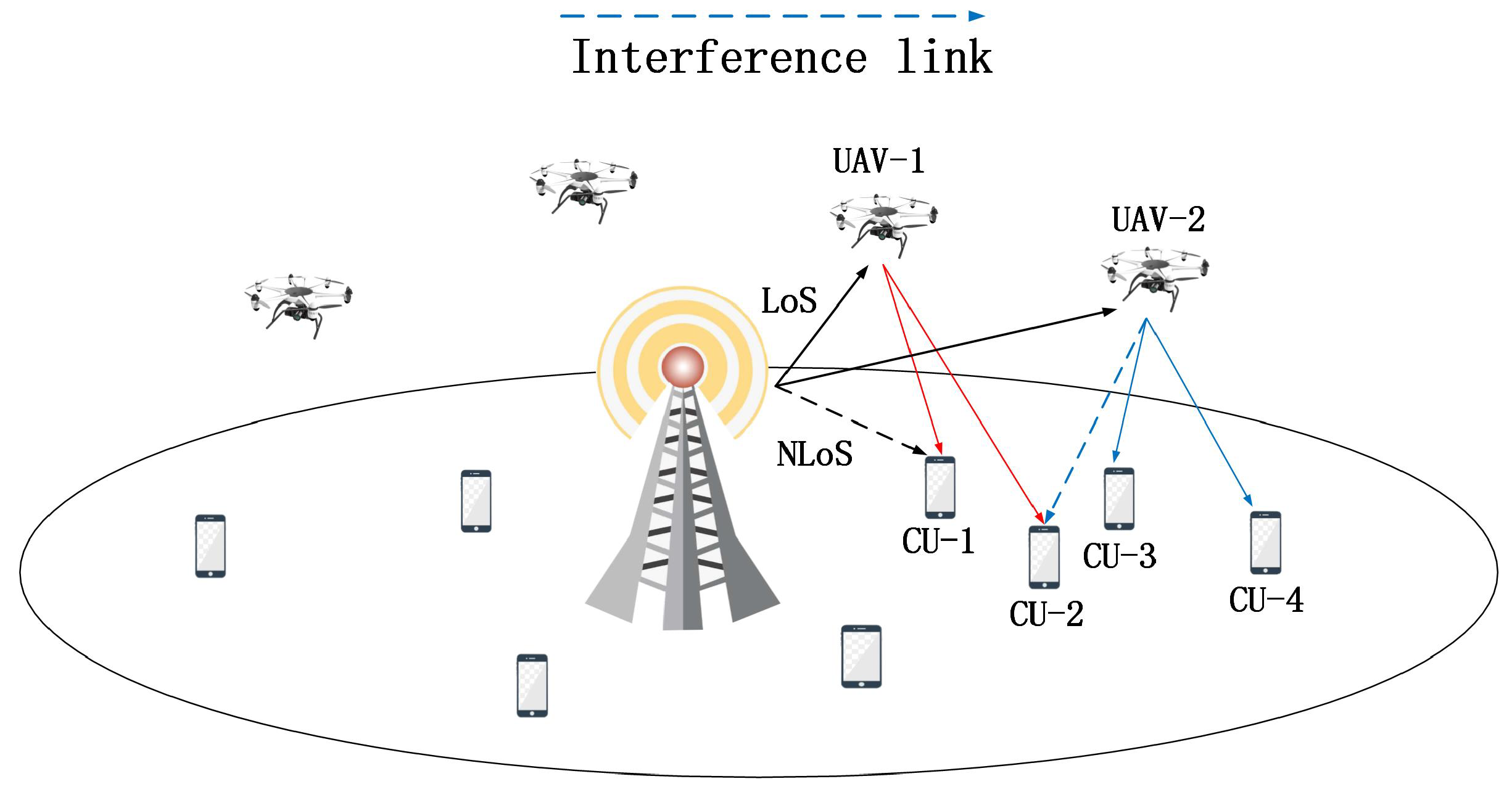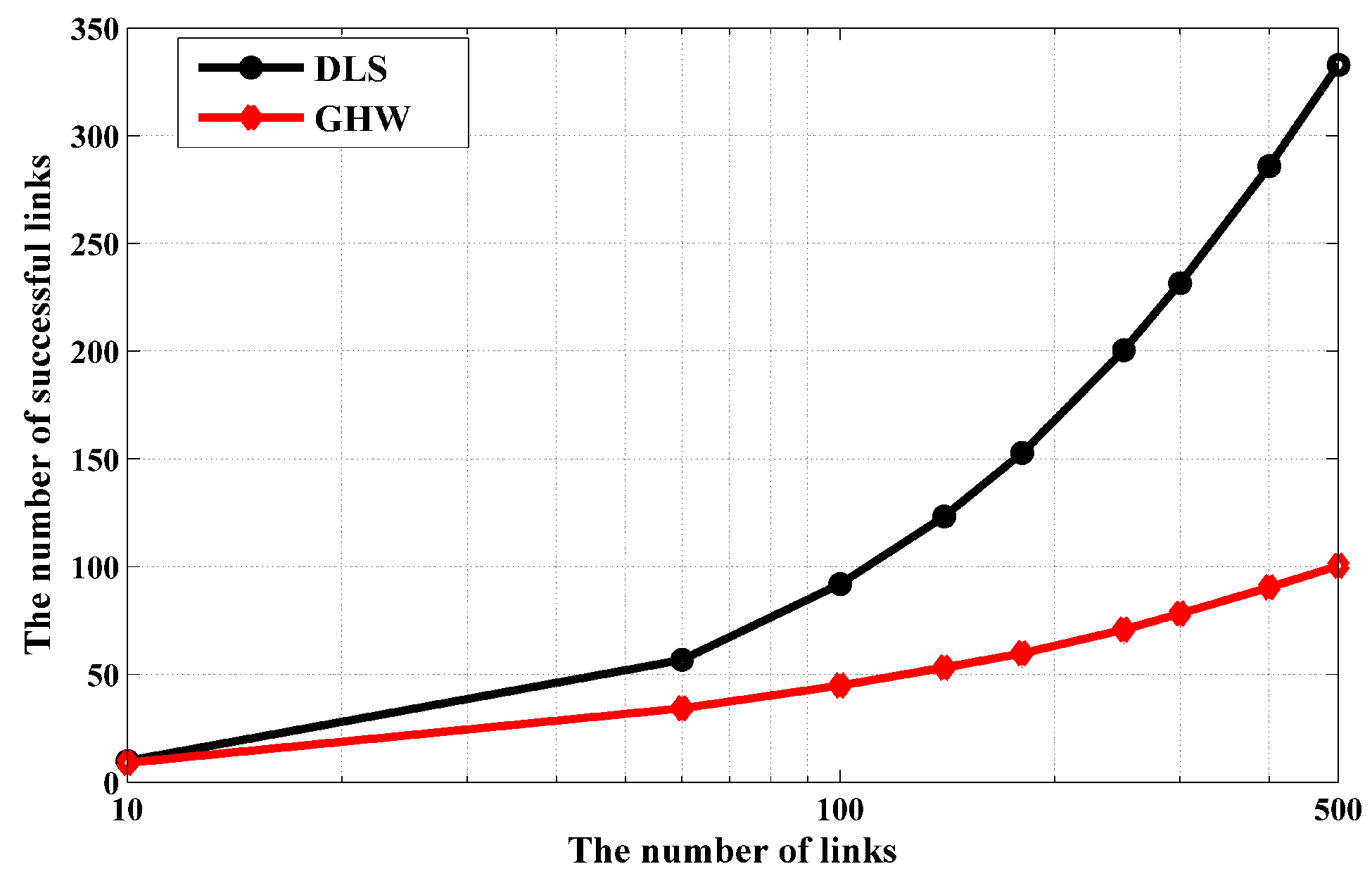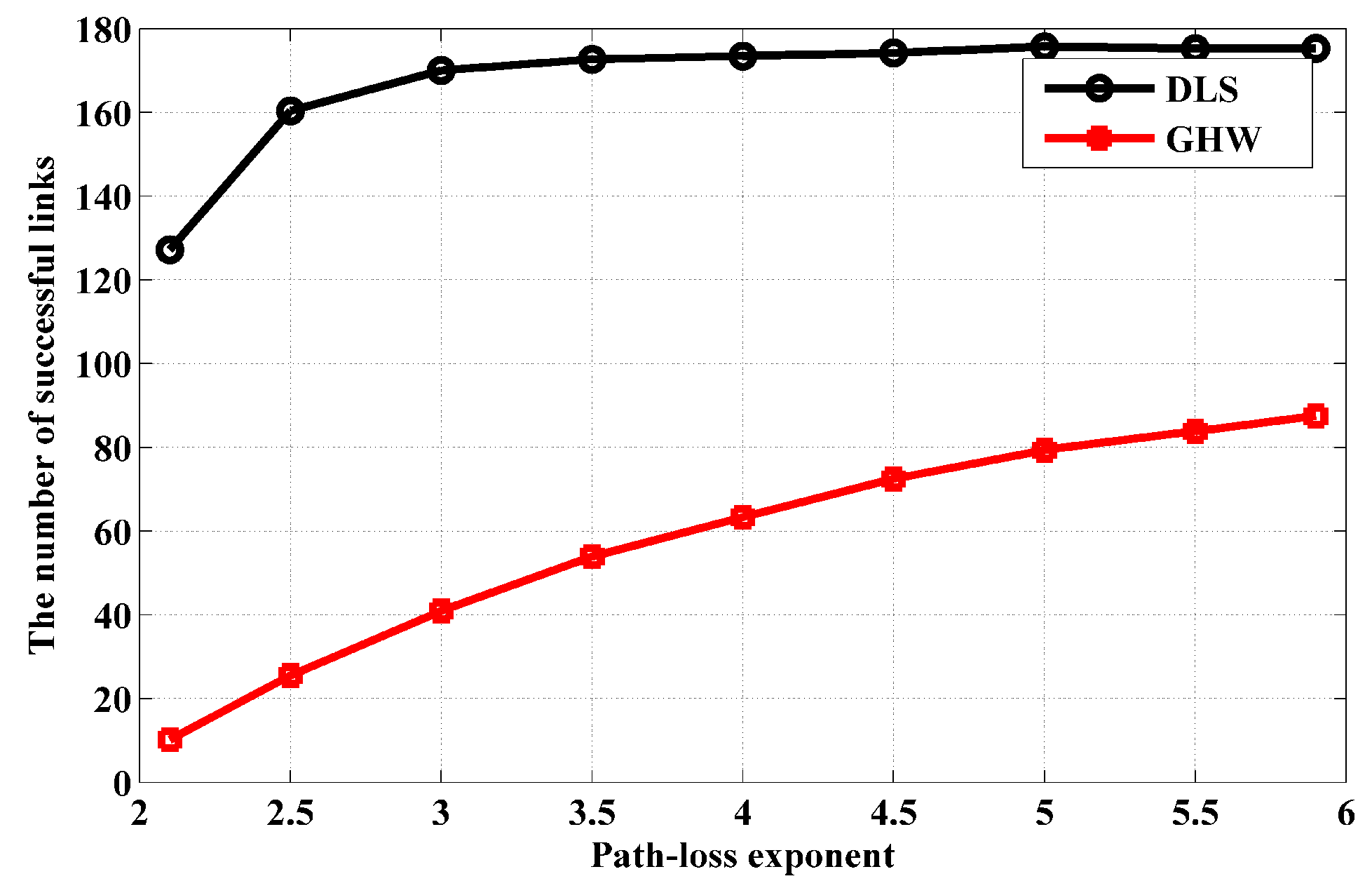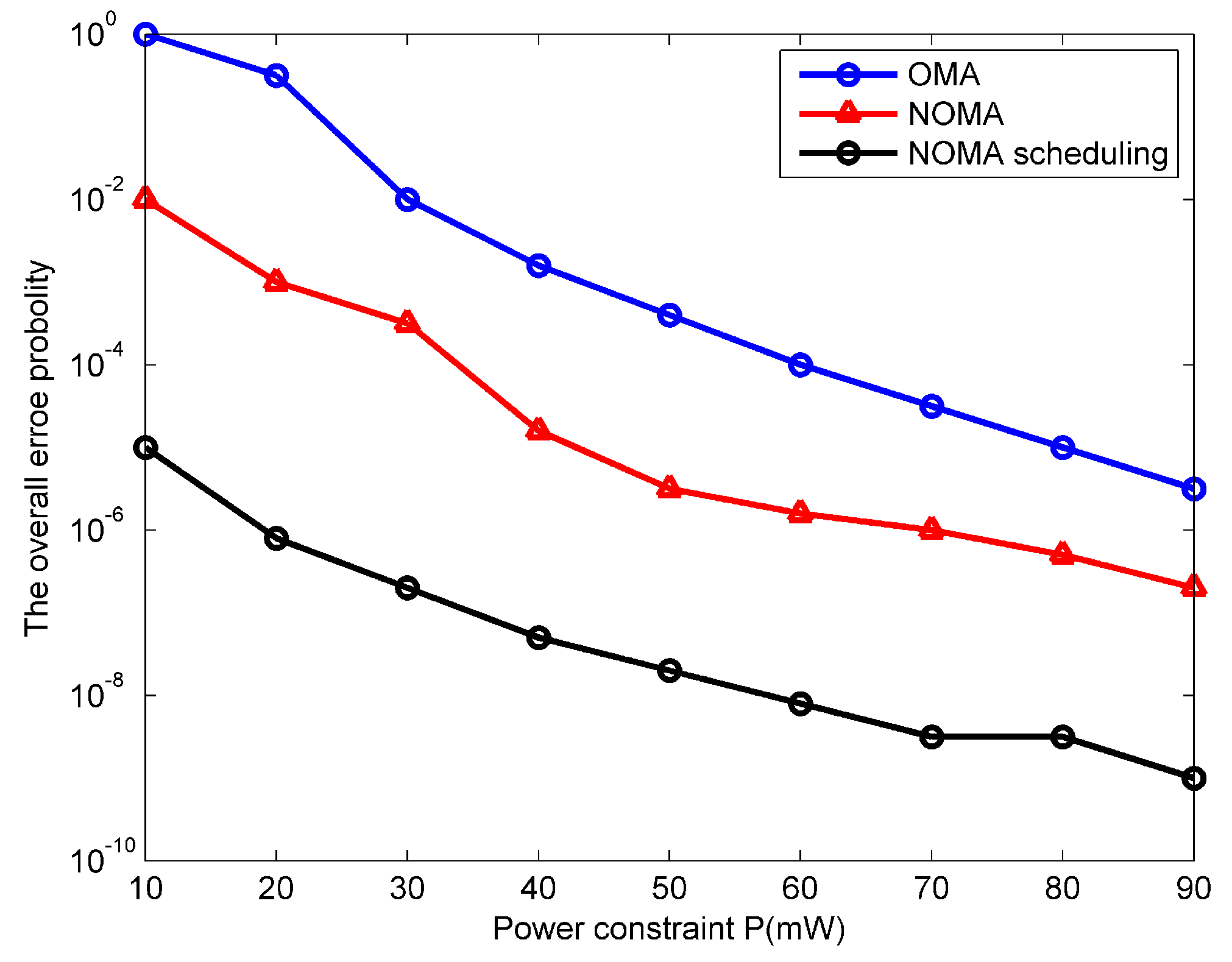NOMA and UAV Scheduling for Ultra-Reliable and Low-Latency Communications
Abstract
1. Introduction
- By assuming that UAVs operate in crowded cities, we describe the statistical properties of SINR of CU under a three-dimensional model. The average path loss of the LoS and NLoS links is computed in accordance with the potential of constructing a LoS link between the UAV and CU, and the SINR expression of the CU may be obtained.
- In order to avoid the interference of non-associated UAVs on CU, we introduce link scheduling technology. Through the distributed DLS algorithm, we propose an algorithm for scheduling UAV according to DLS, which determines the switching state of each UAV and minimizes the interference level between parallel transmissions.
- In this paper, we introduce NOMA into uRLLC. To reduce the likelihood of an error, we maximize the power management and allocation of the total channel block length. Given the limitations of service quality, we optimized the resource allocation scheme from UAV to CU.
2. Related Work
3. Network Model
3.1. Channel Model
3.2. QoS Requirements
3.3. Problem Formulation and Solution
4. UAV Scheduling and Resource Allocation Scheme
4.1. UAV-Scheduling Scheme
| Algorithm 1 UAV-CU association scheme. |
|
| Algorithm 2 UAV-scheduling scheme. |
|
4.2. Resource Allocation Scheme
4.2.1. Transmission Scheme from UAV to CU
4.2.2. Transmission Scheme from BS to UAV
4.2.3. Queuing Scheme
4.3. Algorithm Analysis
5. Simulation and Numerical Results
5.1. MLS Simulation
5.2. Packet Error Rate Simulation
6. Conclusions
Author Contributions
Funding
Institutional Review Board Statement
Informed Consent Statement
Data Availability Statement
Conflicts of Interest
References
- Bennis, M.; Debbah, M.; Poor, H. Ultrareliable and low-latency wireless communication: Tail, risk, and scale. Proc. IEEE 2018, 106, 1834–1853. [Google Scholar] [CrossRef]
- Mendis, H.; Li, F. Achieving ultra reliable communication in 5g networks: A dependability perspective availability analysis in the space domain. IEEE Commun. Lett. 2017, 21, 2057–2060. [Google Scholar] [CrossRef]
- Meredith, J. Study on enhanced lte support for aerial vehicles. 3GPP Sophia Antipolis Fr. Rep. TR 2017, 36, 116–125. [Google Scholar]
- Gupta, L.; Jain, R.; Vaszkun, G. Survey of important issues in uav communication networks. IEEE Commun. Surv. Tutor. 2016, 18, 1123–1152. [Google Scholar] [CrossRef]
- Zeng, Y.; Zhang, R.; Lim, T. Wireless communications with unmanned aerial vehicles: Opportunities and challenges. IEEE Commun. Mag. 2016, 54, 36–42. [Google Scholar] [CrossRef]
- Tao, Y.; Liu, L.; Liu, S.; Zhang, Z. A survey: Several technologies of non-orthogonal transmission for 5g. China Commun. 2015, 12, 1–15. [Google Scholar] [CrossRef]
- Liaqat, M.; Noordin, K.; Latef, T.; Dimyati, K. Power-domain non orthogonal multiple access (pd-noma) in cooperative networks: An overview. Wirel. Netw. 2020, 26, 181–203. [Google Scholar] [CrossRef]
- Su, X.; Castiglione, A.; Esposito, C.; Choi, C. Power domain noma to support group communication in public safety networks. Future Gener. Comput. Syst. 2018, 84, 228–238. [Google Scholar] [CrossRef]
- Mei, W.; Zhang, R. Uplink cooperative noma for cellular-connected uav. IEEE J. Sel. Top. Signal Process. 2019, 13, 644–656. [Google Scholar] [CrossRef]
- Nasir, A.; Tuan, H.; Duong, T.; Poor, H. Uav-enabled communication using noma. IEEE Trans. Commun. 2019, 67, 5126–5138. [Google Scholar] [CrossRef]
- Liu, M.; Yang, J.; Gui, G. Dsf-noma: Uav-assisted emergency communication technology in a heterogeneous internet of things. IEEE Internet Things J. 2019, 6, 5508–5519. [Google Scholar] [CrossRef]
- Andrews, J.; Buzzi, S.; Choi, W.; Hanly, S.; Lozano, A.; Soong, A.; Zhang, J. What will 5g be? IEEE J. Sel. Areas Commun. 2014, 32, 1065–1082. [Google Scholar] [CrossRef]
- Gupta, A.; Jha, R. A survey of 5g network: Architecture and emerging technologies. IEEE Access 2015, 3, 1206–1232. [Google Scholar] [CrossRef]
- Dams, J.; Hoefer, M.; Kesselheim, T. Scheduling in wireless networks with rayleigh-fading interference. IEEE Trans. Mob. Comput. 2015, 7, 1503–1514. [Google Scholar] [CrossRef]
- Yu, K.; Yu, J.; Cheng, X.; Yu, D.; Dong, A. Efficient link scheduling solutions for the internet of things under rayleigh fading. IEEE/ACM Trans. Netw. 2021, 29, 2508–2521. [Google Scholar] [CrossRef]
- Yu, K.; Yu, J.; Dong, A. Cooperative communication and mobility for securing urllc of future wireless networks. IEEE Trans. Veh. Technol. 2021, 71, 5331–5342. [Google Scholar] [CrossRef]
- Yu, K.; Wang, Y.; Yu, J.; Yu, D.; Cheng, X.; Shan, Z. Localized and distributed link scheduling algorithms in iot under rayleigh fading. Comput. Netw. 2019, 151, 232–244. [Google Scholar] [CrossRef]
- She, C.; Liu, C.; Quek, T.; Yang, C.; Li, Y. Ultra-reliable and low-latency communications in unmanned aerial vehicle communication systems. IEEE Trans. Commun. 2019, 67, 3768–3781. [Google Scholar] [CrossRef]
- Ren, H.; Pan, C.; Wang, K.; Deng, Y.; Elkashlan, M.; Nallanathan, A. Achievable data rate for urllc-enabled uav systems with 3-d channel model. IEEE Wirel. Commun. Lett. 2019, 8, 1587–1590. [Google Scholar] [CrossRef]
- Kotaba, R.; Manchón, C.; Balercia, T.; Popovski, P. How urllc can benefit from noma-based retransmissions. IEEE Trans. Wirel. Commun. 2021, 20, 1684–1699. [Google Scholar] [CrossRef]
- Ghanem, W.; Jamali, V.; Zhang, Q.; Schober, R. Joint uplink-downlink resource allocation for ofdma-urllc mec systems. In Proceedings of the GLOBECOM 2020—2020 IEEE Global Communications Conference, Taipei, Taiwan, 7–11 December 2020; pp. 1–7. [Google Scholar]
- Zhai, D.; Li, H.; Tang, X.; Zhang, R.; Ding, Z.; Yu, F. Height optimization and resource allocation for noma enhanced uav-aided relay networks. IEEE Trans. Commun. 2021, 69, 962–975. [Google Scholar] [CrossRef]
- Halldórsson, M. Wireless scheduling with power control. ACM Trans. Algorithms 2012, 9, 1–20. [Google Scholar] [CrossRef]
- Fanghanel, A.; Kesselheim, T.; Vocking, B. Improved algorithms for latency minimization in wireless networks. Theor. Comput. Sci. 2011, 412, 2657–2667. [Google Scholar] [CrossRef]
- Huang, B.; Yu, J.; Yu, D.; Ma, C. Sinr based maximum link scheduling with uniform power in wireless sensor networks. KSII Trans. Internet Inf. Syst. 2014, 8, 4050–4067. [Google Scholar]
- Huang, B.; Yu, J.; Cheng, X.; Chen, H.; Liu, H. Sinr based shortest link scheduling with oblivious power control in wireless networks. J. Netw. Comput. Appl. 2017, 77, 64–72. [Google Scholar] [CrossRef]
- Moscibroda, T.; Wattenhofer, R. The complexity of connectivity in wireless networks. In Proceedings of the INFOCOM 2006: 25th Annual Joint Conference of the IEEE Computer and Communications Societies, Barcelona, Spain, 23–29 April 2006. [Google Scholar]
- Goussevskaia, O.; Wattenhofer, R.; Halldorsson, M.; Welzl, E. Capacity of arbitrary wireless networks. In Proceedings of the IEEE INFOCOM 2009, Rio de Janeiro, Brazil, 19–25 April 2009; pp. 1872–1880. [Google Scholar]
- Chaporkar, P.; Kar, K.; Luo, X.; Sarkar, S. Throughput and fairness guarantees through maximal scheduling in wireless networks. IEEE Trans. Inf. Theory 2008, 54, 572–594. [Google Scholar] [CrossRef]
- Weber, S.; Andrews, J. Transmission capacity of wireless networks. arXiv 2012, arXiv:1201.0662. [Google Scholar]
- Fanghänel, A.; Geulen, S.; Hoefer, M.; Vöcking, B. Online capacity maximization in wireless networks. J. Sched. 2013, 16, 81–91. [Google Scholar] [CrossRef]
- Yu, J.; Huang, B.; Cheng, X.; Atiquzzaman, M. Shortest link scheduling algorithms in wireless networks under the sinr model. IEEE Trans. Veh. Technol. 2017, 66, 2643–2657. [Google Scholar] [CrossRef]
- Halldórsson, M.; Mitra, P. Nearly optimal bounds for distributed wireless scheduling in the sinr model. Distrib. Comput. 2016, 29, 77–88. [Google Scholar] [CrossRef]
- Zeng, Y.; Zhang, R.; Lim, T. Throughput maximization for uav-enabled mobile relaying systems. IEEE Trans. Commun. 2016, 64, 4983–4996. [Google Scholar] [CrossRef]
- Wang, K.; Pan, C.; Ren, H.; Xu, W.; Zhang, L.; Nallanathan, A. Packet error probability and effective throughput for ultra-reliable and low-latency uav communications. IEEE Trans. Commun. 2021, 69, 73–84. [Google Scholar] [CrossRef]






Disclaimer/Publisher’s Note: The statements, opinions and data contained in all publications are solely those of the individual author(s) and contributor(s) and not of MDPI and/or the editor(s). MDPI and/or the editor(s) disclaim responsibility for any injury to people or property resulting from any ideas, methods, instructions or products referred to in the content. |
© 2023 by the authors. Licensee MDPI, Basel, Switzerland. This article is an open access article distributed under the terms and conditions of the Creative Commons Attribution (CC BY) license (https://creativecommons.org/licenses/by/4.0/).
Share and Cite
Liu, X.; Xu, X.; Yu, K. NOMA and UAV Scheduling for Ultra-Reliable and Low-Latency Communications. Drones 2023, 7, 41. https://doi.org/10.3390/drones7010041
Liu X, Xu X, Yu K. NOMA and UAV Scheduling for Ultra-Reliable and Low-Latency Communications. Drones. 2023; 7(1):41. https://doi.org/10.3390/drones7010041
Chicago/Turabian StyleLiu, Xiaowu, Xihan Xu, and Kan Yu. 2023. "NOMA and UAV Scheduling for Ultra-Reliable and Low-Latency Communications" Drones 7, no. 1: 41. https://doi.org/10.3390/drones7010041
APA StyleLiu, X., Xu, X., & Yu, K. (2023). NOMA and UAV Scheduling for Ultra-Reliable and Low-Latency Communications. Drones, 7(1), 41. https://doi.org/10.3390/drones7010041




